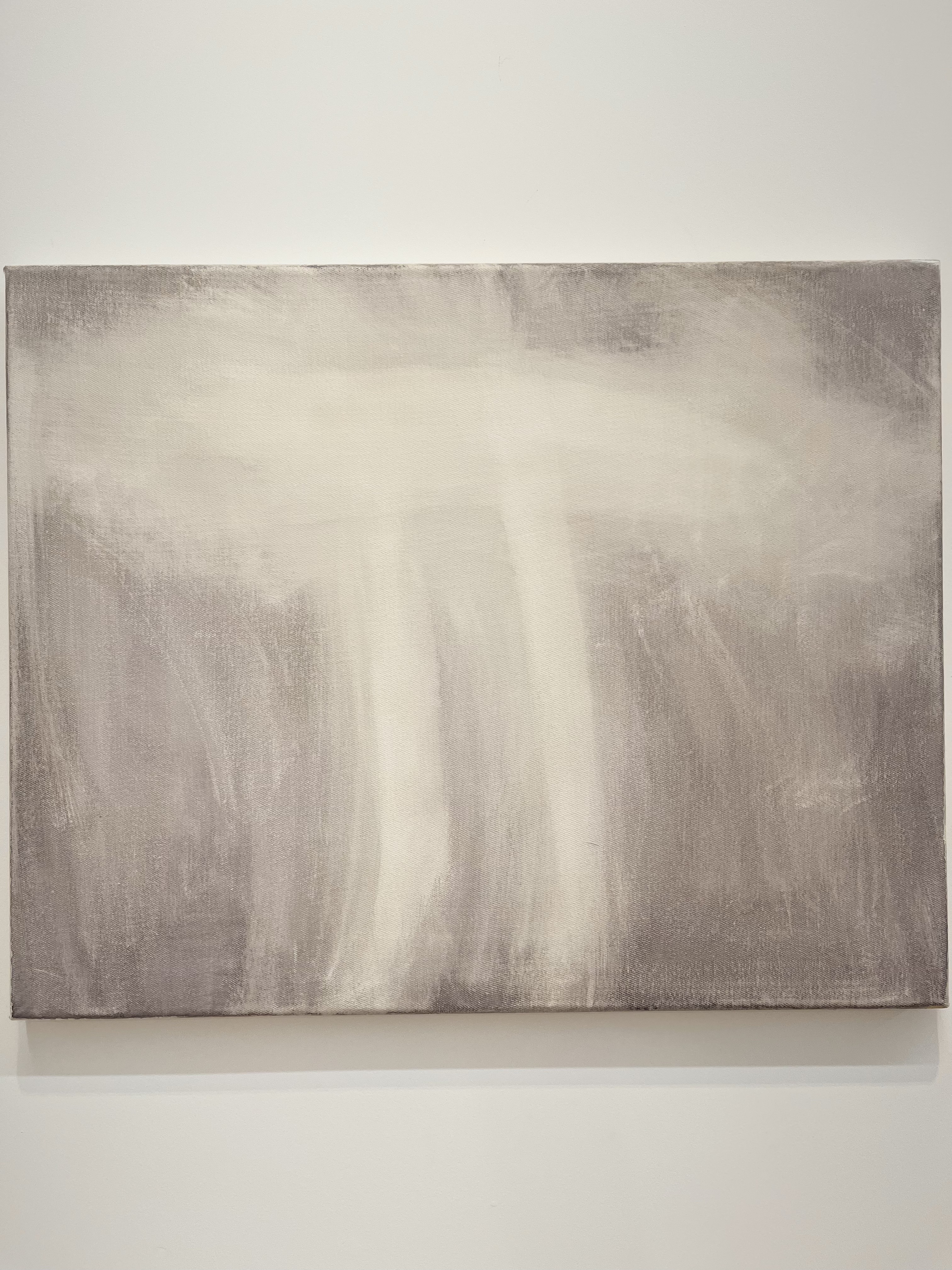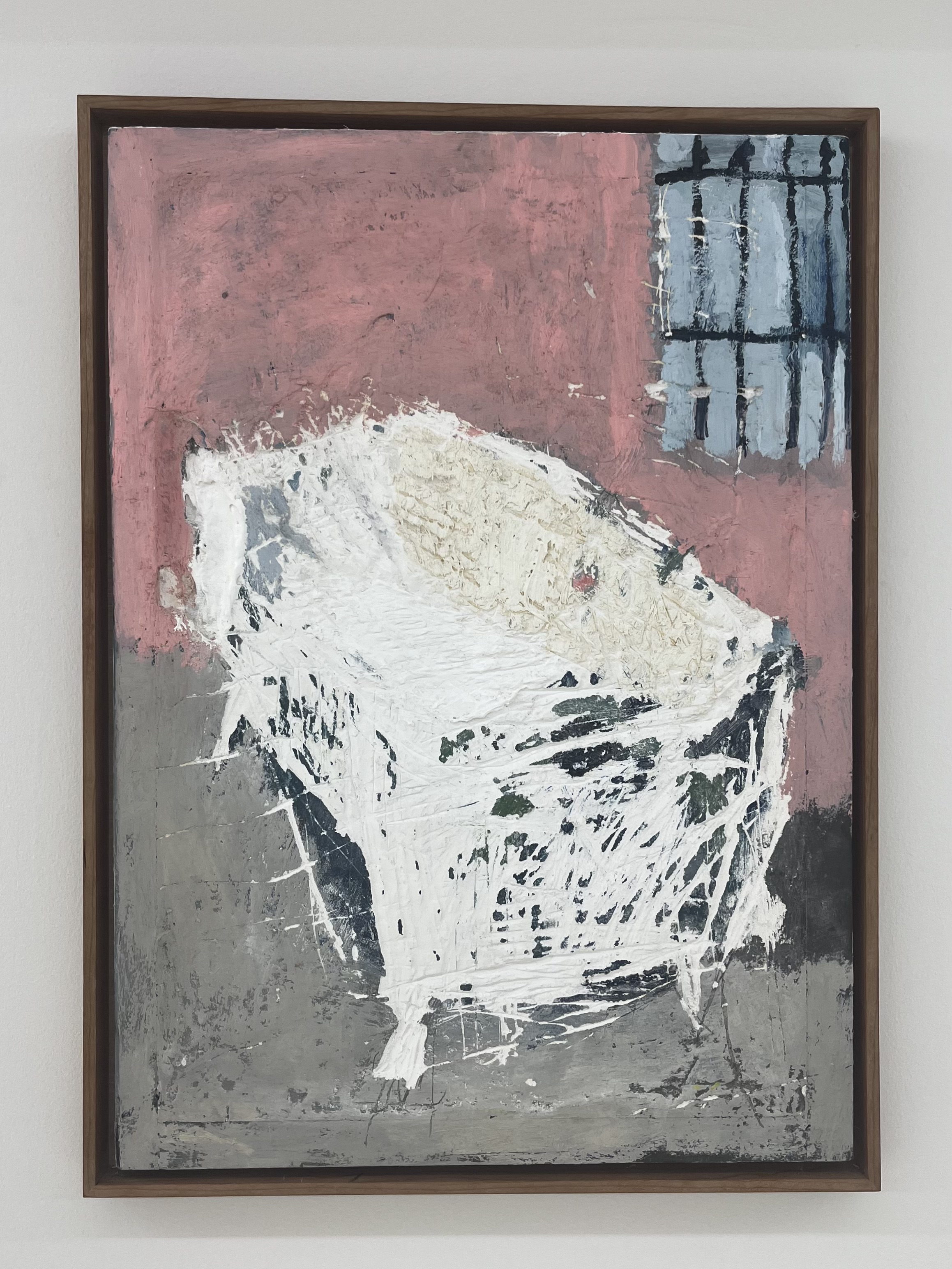
Kim Stolz, “15:44” (2022). All photos by the author.
Two Painting Shows Explore the Inexpressible
On Kim Stolz at YveYANG Gallery and Jack Albrittain At Ruby/Dakota Gallery.
By Theodora Bocanegra Lang
10.21.2024
Abstract painting does not always welcome written interpretation. I often find myself going back to the basics of visual analysis, isolating formal qualities of composition, color, line, and texture. Two recent painting shows bring me back to these guidelines, though I find them inadequate in describing what I observed. Painters Kim Stolz and Jack Albrittain focus on this disparity, foregrounding the personal and inexpressible in their works.
In Kim Stolz’s matter-of-factly titled exhibition at YveYANG Gallery, thirteen paintings, the works on view are unpretentious and playful, evidencing the artist’s repetitive thought process and workflow. Each is titled after a time of day, and though the paintings are firmly abstract, this naming transports us into the studio with the artist and illuminates the context in which the works were made. “10:40” is a bundle of green and brownish horizontal strokes, mapping the arc of Stolz’s hand as it starts at one edge of the canvas and stops before the other. Stolz paints her works on the ground, and each work indexes the way she moves. The paint appears thin and slippery as skim milk, barely opaque, forming sinking liquid layers on woven cotton and linen. The resulting paintings are delicate, emotive, and quiet.
“13:47” is a pale, hazy blur of white and light gray watercolor on cotton. Cloudy and soft, the painting resembles a foggy pane of glass on a cold and dim day. The paint is so thin and fluid that it barely settles onto the cloth’s surface, recalling the experience of standing close to a window, breathing, and leaving a transient layer of moisture behind. The titles serve as observational labels, recording and archiving key information about the conditions of production while implying a mysterious and methodical daily practice. What is the difference between a morning painting and an evening painting, a rainy day painting and a sunny one?

Kim Stolz, “13:47” (2024)
At Ruby/Dakota Gallery, painter Jack Albrittain experiments with opposites in 6 poems. The show presents a wide range of paintings both big and small, abstract and representational, flat and chunky. Where Stolz’s paintings are soft, gentle, and ephemeral, Albrittain’s are a mix of subtle, intense, and hefty, venturing into murky spaces of partial memory and watery focus.
Using a mostly faded and pastel color palette, Albrittain plays with tension and juxtaposition. Some works use blended and hazy layered washes, flexible and abstract, while others depict birds, houses, or lawn chairs in thick masses of paint where the substance itself becomes sculptural. This flitting between opposites adds intrigue and provides a kind of rhythm to the exhibition. Side-by-side “Bird Painting (Sparrow)” and “Bathers” are funny and light: pairing a tiny work of a bird with an enormous gestural painting of three oversized birds invites absurdity and subjectivity in squaring the disparate depictions of the same thing. Other works like “Lavender Cracks” seem tortured and weathered, with globs of paint marked by agitated scratches. “Bugonia,” an off-white and burly abstract work, has nails hammered through it, some remaining and some removed, leaving little wounds behind. The oscillation between peaceful scenery and active, weighty abstraction evokes confusion, or a mood swing, as is echoed in the poem-as-press-release by gallerist Hannah Studnick:
“messy, well, frenetic, Dead
And writhing.”
The works are tumultuous and energetic, but also calm and reflective. “Bathtub” embodies these tensions in a single work, using gloopy layered paint to scratch out a white clawed bath in a pink room. The scene is delicate, but the pocked surface tells another story, with scooped out chunks, craters, and scrapes.

Jack Albrittain, “Bathtub” (2024)
Like Stolz’s works, Albrittain’s paintings resemble snapshots, capturing individual moments in time as well as sentiments. Though the painters both use similar tools of abstraction and paint, they incorporate their own techniques of tumult, haziness, clarity, and precision to express things inexpressible. Far from the cynical, calculated, and glib works that have proliferated across the art world in recent years, Stolz and Albrittain argue the value of the quotidian, delicate, and sincere in painting, eschewing distant subjects for personal feeling.
Stay up to date on YveYANG here and Ruby/Dakota here.
